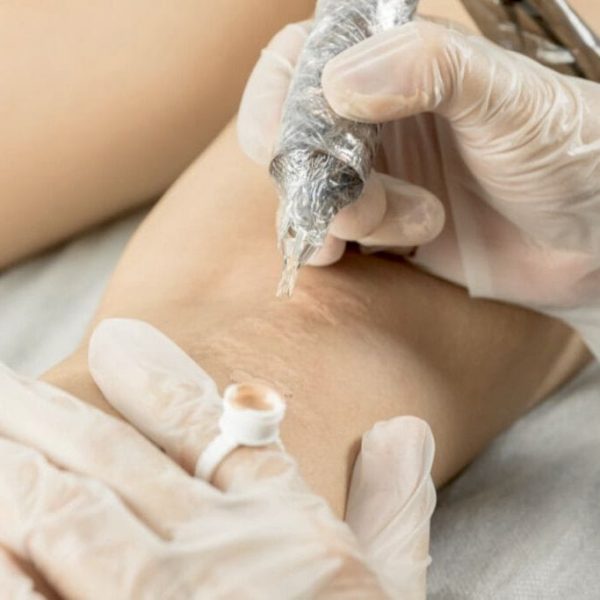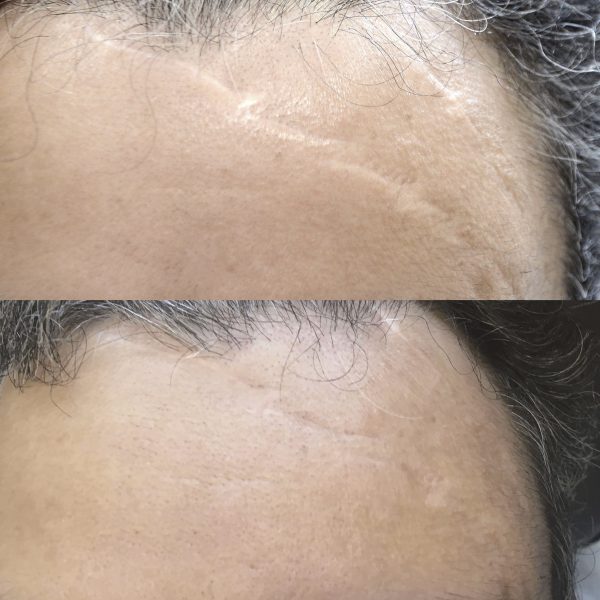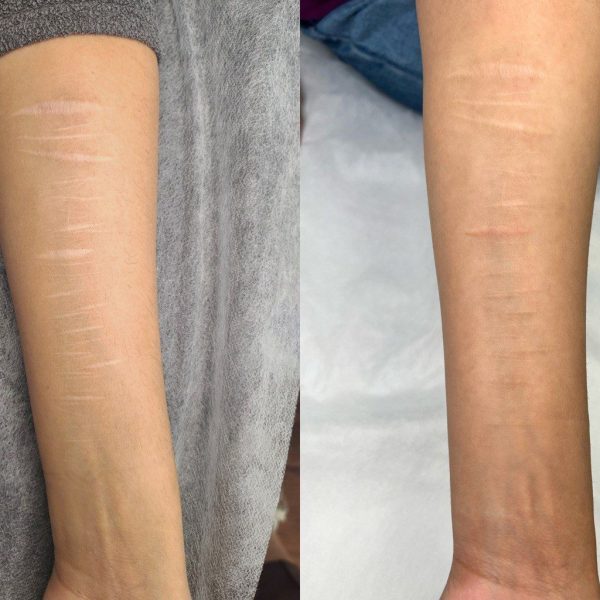


Scar camouflage treatment is a long term solution to scarring, which effectively conceal even seriously disfiguring scars.
What Is Scar Camouflage?
In most cases, camouflage is the only way to eliminate a defect. The pigment is selected as naturally as possible to make the scar invisible in the final result.
After the camouflage procedure, you may notice slight redness around the treated area. But after three days, these symptoms will pass, and you will be satisfied. The recovery period lasts about a week. After that, the scar becomes invisible.
Indications in the Procedure
- Scars after abdominal operations.
- Scar after appendicitis.
- C-section.
- Laparoscopic operations.
- Burns on the face and body.
- Scars on the eyebrows, lips, and other face areas.
Why Do Clients Choose Camouflage?
- You don’t feel pain during the procedure as we use powerful anesthesia.
- Minimal trauma compared to other methods of scar smoothing.
- Minimal rehabilitation. Complete healing takes a week compared to months after surgical removal.
- Versatility. Scar camouflage works in cases when other methods are already powerless.
- Long-term effect. The result of the procedure lasts up to 3 years.
- It promotes skin tightening and smoothing and does not provoke pigmentation.
How Is the Procedure Carried Out?
Before a scar camouflage tattoo session, you should not take blood-thinning medicine for three days. It is also worth giving up aspirin, tea, coffee, and energy drinks for this period.
And how is camouflage carried out? The studio technician selects the tone of the pigment relative to your skin tone. With the help of a special marker, she sketches the treated area. After the client’s full consent, the technician proceeds to anesthetize the area with creams or sprays. Finally, the specialist inserts the desired shade’s pigment using a maniple.
The procedure lasts an hour to two, depending on what area needs processing.
Aftercare Instructions
At the end of the procedure, the studio technician will provide a series of care recommendations. Understanding that the final result depends on how you care for the camouflage is essential.
The treated area of the skin must be lubricated with a regenerating cream. Limit yourself to swimming pools, saunas, and spas until complete recovery. Proper and regular care of scar camouflage during the restoring period will delight you with high-quality results for many years.
About Scar Camouflage treatment
Scar camouflage treatment is a specialized procedure aimed at concealing the appearance of scars, making them less noticeable. This treatment can be particularly beneficial for individuals with scars resulting from surgery, injury, burns, or skin conditions like acne. Here’s a detailed overview of scar camouflage treatment:
Types of Scar Camouflage Treatments
Medical Tattooing (Micropigmentation):
- Procedure: A trained technician uses a needle to implant pigment into the skin, matching the color of the surrounding skin to camouflage the scar.
- Effectiveness: Can significantly reduce the visibility of scars, particularly effective for flat scars and stretch marks.
- Duration: Results can last several years, but touch-ups may be needed.
Microneedling:
- Procedure: Tiny needles create micro-injuries in the scar tissue, stimulating collagen production and improving texture and appearance.
- Combination: Often combined with serums or PRP (Platelet-Rich Plasma) for enhanced results.
Laser Therapy:
- Types: Fractional CO2 laser, Er
laser, and Pulsed Dye Laser (PDL).
- Purpose: Resurfaces the skin, reducing scar thickness and discoloration.
- Effectiveness: Particularly useful for hypertrophic and keloid scars.
- Types: Fractional CO2 laser, Er
Chemical Peels:
- Purpose: Exfoliate the top layers of skin, promoting new skin growth and improving the appearance of scars.
- Types: Various acids (e.g., glycolic acid, salicylic acid) are used depending on the scar type.
Dermal Fillers:
- Substance: Hyaluronic acid or collagen-based fillers.
- Purpose: Fill in depressed scars to make them level with the surrounding skin.
- Duration: Results are temporary, typically lasting 6-12 months.
Procedure Steps for Medical Tattooing
Consultation:
- Assessment: Evaluation of the scar type, size, color, and location.
- Color Matching: Determining the exact pigment shade to match the surrounding skin.
Preparation:
- Cleaning: The scar and surrounding area are thoroughly cleaned.
- Numbing: A topical anesthetic may be applied to minimize discomfort.
Pigmentation:
- Application: Using a tattoo machine, the pigment is implanted into the dermal layer of the skin.
- Technique: Multiple sessions may be required for optimal results.
Aftercare:
- Instructions: Patients receive guidelines on how to care for the treated area, including avoiding sun exposure and keeping the area clean.
- Healing: The treated area may take several weeks to heal fully.
Advantages of Scar Camouflage Treatment
- Aesthetic Improvement: Significantly reduces the visual impact of scars.
- Confidence Boost: Helps individuals feel more confident about their appearance.
- Non-Invasive Options: Several treatments are non-invasive or minimally invasive.
Risks and Considerations
- Side Effects: Possible side effects can include redness, swelling, infection, and allergic reactions to pigments.
- Color Mismatch: There is a risk of the pigment not perfectly matching the surrounding skin, especially with changes in skin tone due to sun exposure or aging.
- Multiple Sessions: Some treatments require multiple sessions to achieve the desired results.
Choosing a Provider
- Qualifications: Ensure the provider is certified and experienced in scar camouflage techniques.
- Portfolio: Review before-and-after photos of previous clients.
- Consultation: A thorough consultation is crucial to discuss expectations, risks, and care instructions.
Scar camouflage treatment offers a range of solutions to improve the appearance of scars, tailored to the individual’s needs and the specific characteristics of their scars. Consulting with a qualified professional can help determine the best approach for achieving optimal results.



